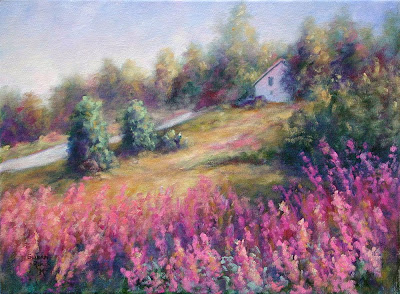
Golden Warmth
Original oil painting 14x18" (sold)
by Susan Roux
Its so important in painting. Its so simple to do. But I think its one of the aspects of painting that is not clearly understood by all. I also think its a lesson that can greatly improve art.
Its the magic tool to create depth on your canvas.
Yes, I know perspective lines create the illusion of depth. But what if there are no structures with receding lines in your painting? Its often the case with landscapes, even still life's. What then? How do you show distance? There is more than size reduction available as your tools.
I teach to beginners. I mean people who have never painted before and don't know how to draw. In 8 two-hour sessions I get them to complete a painting that totally surprises them. There is depth, contrast, unity in color, a captivating composition and a clear focal point. They are so excited about their achievement that most continue on as my students. How do I get them to achieve all this when they've never done or studied anything about art? Neutralizing color.
I will explain it to you as simply as I explain it to them.
Particles in the air. Lots and lots of particles exist in the air. Moisture, dust and who knows what else. We've all seen it. That ray of sunshine that flows in the house with all that "stuff" hovering in it. Can my house be that dusty??? Its everywhere, though we can't usually see it. Now imagine a snowstorm. (In Maine, this analogy works very well...) When its snowing lightly, you can see across the street, but everything looks muted, hazy, filmy. Not like a nice clear view. If its snowing very hard, you can't even see across the street. Why? Its due to all the snowflakes obstructing the view, right? Yes. (For those of you in sunny Florida, you'll have to use your imagination...) Particles in the air do the same thing.
They obstruct the view. The farther something is from us, the more the view is obstructed. This causes every aspect of it to become muted, hazy, filmy. This relates to its color, its detail (usually lack there-of) and its form.
We are all aware that mountains in the distance appear blue, gray, even purple... But what about something across the street? In painting, neutralizing color in various degrees will show distance every time.
Its the most repeated phrase in my teaching. "If something is in the distance, what do we do? Neutralize color!"
Here's the secret formula. Better take out your pen, because its very complicated...
Every color can be neutralized. All that is needed is all three primary colors together. Red, yellow and blue.
When mixed equally, your paint will turn gray. When mixed with one prominent color, it will continue to hold the property of that color, but it will dull out. If you mix the color you want, say "green". Stop and think which primaries are already present. Blue and yellow. The red component is missing. So any "red" on your palette, be it alizarine, cadmium, magenta, purple etc. can be added in small quantity to your green to neutralize it.
There's no need for a complicated color wheel with primary colors, complimentary colors and everything else to confuse you. Just the understanding of needing all three primaries. Red, yellow and blue.
It works for every color. Just mix the color you desire first and then add what is missing. If you want a soft yellow, then mix your desired shade and afterwards add a very small amount of red and blue. If your dealing with light shades, pastel shades, you may find it easier to create pastel versions of both your red and blue before adding them in. (You can make a pale lavender to use...) If your soft yellow neutralizes to gray, simply add more yellow until it pulls back to the yellow property. With time neutralizing, with the correct amount of added primaries, will become easier.
Tomorrow I'll explain how to get neutralized color to work for you. How to implement it into your paintings for optimal impact. Be ready to see instant improvement if you're not already utilizing the wonderful tool of neutralized color.
Happy painting everyone!

I love your lessons and they way you explain them. It makes me feel not so stupid... haha great job! and your painting is beautiful.
ReplyDeleteA good lesson, Susan . . .
ReplyDeleteNora
great lesson about atmospheric perspective. I love the way you explain it..can you imagine what the Iceland volcano will do to the plein air painters in Europe?
ReplyDeleteGreat post... so true..
ReplyDeleteVery well explained... clear and articulate!!
Glad I dropped by, Susan!
what a lovely painting, and what a great post! thanks for sharing this.
ReplyDeletesusan,
ReplyDeletelove your painting...
the lesson also is great...
Loved that nice easy way you explained that once again my visit to your blog has not been in vain. Thank you again
ReplyDeleteTu m'as inscrite à tes cours prochains??? Bisousssssssssssss
ReplyDeleteThank you all. I'm glad you enjoyed the lesson. As for its simpleness, I've worked very hard over the years to find simple ways to explain things to my beginners. The less complicated it is, the better they understand. And with it comes very good results!
ReplyDelete